|
RECOMMENDED
BATTERIES
(Background Information)
DO NOT BUY BATTERIES FOR ROBOT WARS UNTIL YOU HAVE READ THIS!
| Battery Recommendations | (although you should read the text below first!)
Batteries constitute one of the major expenses and most confusing items required for a robot. All teams seek to minimise their cost, but none wish to sacrifice performance, and few have the facilities to accurately and realistically test those batteries available. We are fortunate to have such facilities, and for the good of everyone, we have made our test results available on our site. Throughout this section, we will assume we are talking about heavyweight robots.
What's a battery? Seriously!
A battery is a group of chemical cells connected together. Each cell is a seperate element, in which a chemical reaction takes place as the cell supplies current. In rechargeable cells, when current is pushed in the opposite direction, the chemical reaction reverses, and the cell is charged. Cells have different characteristics depending on the chemical reaction that happens inside them, one such characteristic is the terminal voltage. The table below summarises the common types of cell.
Cell Technology
Zinc Carbon
Zinc Chloride
Alkaline Manganese
Lithium
Nickel Cadmium
Nickel Metal Hydride
Lead Acid
|
Terminal Voltage
1.5V
1.5V
1.5V
3.0V
1.2V
1.2V
2.0V
|
Rechargeable?
No
No
Not normally
No
Yes
Yes
Yes
|
You can see that what we often call a "battery" is strictly a cell - e.g. the 1.5V alkaline AAA, AA, C and D cells that we are all familiar with. To make a higher voltage battery, a group of cells are connected together in series. The 9V PP3 is a battery - it contains 6 small 1.5V cells. Car batteries and SLAs also have 6 cells, but because each cell is 2V, the terminal voltage of the battery is 12V.
Given the voltages at which most commonly used components in Robot Wars work, and the maximum voltage imposed by the rules, it makes sense to use ready made 12V batteries.
 To complicate matters further, each type of cell technology can have several variations, which do not represent a completely different cell chemistry, but do affect how the cell performs in use. For example, sub C nicad cells as used in radio controlled cars are available in standard 1.2Ah SC, rapid charge 1.4Ah SCR, higher capacity 1.7Ah SCE, special radio controlled 1.7Ah SCRC, and more recent developments of the SCRC cell to provide capacities of 2 or 2.4Ah. Lead acid cells are available as basic Lead Calcium or the more advanced Pure Lead Tin types. The more advanced cells have higher capacity, lower internal resistance and greater efficiency, but normally they cost more!
To complicate matters further, each type of cell technology can have several variations, which do not represent a completely different cell chemistry, but do affect how the cell performs in use. For example, sub C nicad cells as used in radio controlled cars are available in standard 1.2Ah SC, rapid charge 1.4Ah SCR, higher capacity 1.7Ah SCE, special radio controlled 1.7Ah SCRC, and more recent developments of the SCRC cell to provide capacities of 2 or 2.4Ah. Lead acid cells are available as basic Lead Calcium or the more advanced Pure Lead Tin types. The more advanced cells have higher capacity, lower internal resistance and greater efficiency, but normally they cost more!
What batteries can be used?
You need batteries that can be recharged for use in a Robot. The rules recommend that SLA (sealed lead acid) batteries with either a Gel or AGM (absorbent glass mat) electrolyte are used. Ni-Cad and Nimh types can be used, but SLA's represent the most cost effective type for most people. The list of approved batteries on the official site includes:
 Hawker
Hawker
 Yuasa
Yuasa
|
 Dryfit
Dryfit
 Cyclon
Cyclon
|
 Steatite
Steatite
 MicroKiel (Kiel)
MicroKiel (Kiel)
|
We'll go through each type in more detail further on.
How many batteries do I need? - SLAs
Let's assume firstly you're going to use SLAs. To get 24V from 12V SLA batteries, you need a pair of 12V batteries which you then connect in series. To get 36V, you'll need three 12V batteries connected in series. It is possible to combine smaller capacity batteries together in parallel to increase their capacity, but for many reasons it's not recommended. The diagrams below show you what is recommended and what is not.
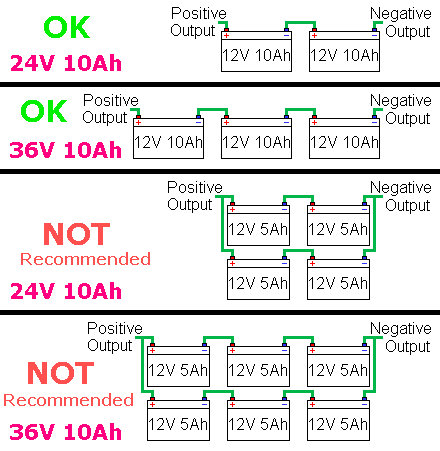
Why are the not recommended situations dangerous? Firstly, if any one of the batteries in the two bad situations above were accidentally connected the wrong way round, it would cancel out the voltage of the battery in series with it, making them both appear like a low value resistor. This means that one side of the batteries would be 24V above the other, which would make a large current flow, in the wrong direction through one (or two if a 36V system) batteries. There's a big chance of a fire, and damage to one or more of your batteries. The diagram below should give you the idea.
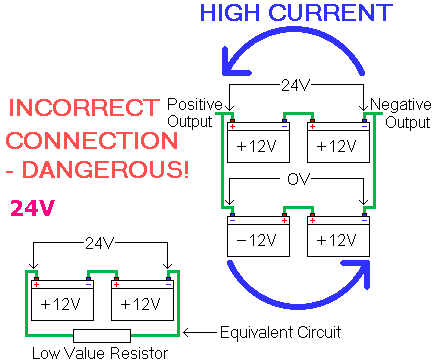
Alternatively, one battery may be connected the correct way round, but for some reason it's not charged. The other side will try to charge it, forcing current through the already charged battery in series with it, overcharging it (and discharging your batteries before you even get into the arena!). Or you may have the situation where one cell in one of the batteries has failed, making its voltage lower. In either case, one of the batteries will probably be damaged.
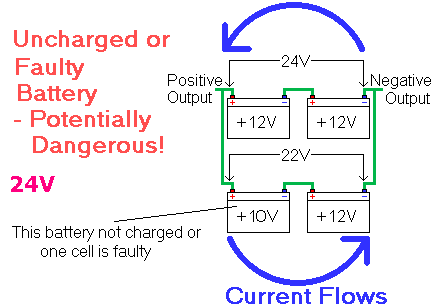
Of course there are many other ways of accidentally shorting a parallel set of batteries, but hopefully you get the idea that if you make a mistake, it could be dangerous. Also note that you can connect both speed controllers in your robot to the same set of batteries - you do not need a seperate set for each motor!
 Robot Wars used to recommend three complete sets of batteries, although with a good charger and a bit of luck you can get away with two sets, especially if you don't realistically expect to progress past the end of your heat. One set is definately not recommended - you're unlikely to get them fully charged in time, and you won't have spares to replace any damaged ones. It's better to have lots of batteries and a slower charger - it'll cost you the same as a big charger and only a few batteries, your batteries will last longer, and you'll have spares.
Robot Wars used to recommend three complete sets of batteries, although with a good charger and a bit of luck you can get away with two sets, especially if you don't realistically expect to progress past the end of your heat. One set is definately not recommended - you're unlikely to get them fully charged in time, and you won't have spares to replace any damaged ones. It's better to have lots of batteries and a slower charger - it'll cost you the same as a big charger and only a few batteries, your batteries will last longer, and you'll have spares.
 For a 24V robot, you'll need four 12V batteries, preferably six.
For a 24V robot, you'll need four 12V batteries, preferably six.
 For a 36V robot, you'll need six 12V batteries, preferably nine.
For a 36V robot, you'll need six 12V batteries, preferably nine.
How many batteries do I need? - Nicads or Nimh
Generally, if you're using Nicad or Nimh batteries you will either be purchasing ready made battery packs (probably 24V or 36V), or making your own up to suit your machine. In simple terms, as the nominal voltage of the cells is 1.2V, you will need 20 cells for a 24V pack or 30 cells for a 36V pack. The problem is that the maximum output current of these type of batteries is quite limited - exceed it and the cell overheats and is damaged. So to increase the output current, you are forced to parallel up packs - and you are back to the problems illustrated above for SLAs in parallel! The only way to do this safely and quickly is to have a seperate voltage-peak charger for each battery pack (see below), and to note the capacity and peak voltage of each pack after charging, such that packs with failing cells can be quickly spotted (lower peak voltage than usual), and the battery put aside for repair. Given the number of packs that must be used and the voltages involved, it's crucial that the overall connections are the right way round. If not, a lot of current will flow, a fire will almost certainly result, and the cells will be destroyed.
 Back to the question: how many packs do you actually need? Well, you've decided on your operating voltage, and you know the current you are going to need to draw from the supply, therefore you can work out the number of packs you need. E.g. if you need to pull 400A, and assuming each pack is capable of 100A, you'll need four battery packs in parallel. Because the capacity removed from the packs will almost always be low (the maximum output current drawn for the five minute battle will not drain the battery completely), you can probably get away with one set of batteries, although if you find the packs come out of the battle warm, you might need two sets (you should never charge warm nicads). If your nicads are getting too hot, then you've probably not got enough packs paralleled up... And none of this takes account of having any spare batteries!
Back to the question: how many packs do you actually need? Well, you've decided on your operating voltage, and you know the current you are going to need to draw from the supply, therefore you can work out the number of packs you need. E.g. if you need to pull 400A, and assuming each pack is capable of 100A, you'll need four battery packs in parallel. Because the capacity removed from the packs will almost always be low (the maximum output current drawn for the five minute battle will not drain the battery completely), you can probably get away with one set of batteries, although if you find the packs come out of the battle warm, you might need two sets (you should never charge warm nicads). If your nicads are getting too hot, then you've probably not got enough packs paralleled up... And none of this takes account of having any spare batteries!
How do I charge my batteries?
Sealed lead acid batteries must be charged carefully. Using the wrong charger can shorten their life to literaly 3 or 4 charges! A standard, off the shelf car battery charger will work for a short while, but it will damage your batteries and they will quickly fail. The reason is that (for most SLA batteries - all lead calcium types) the charging voltage must be carefully limited to between 13.8 and 14.4 volts - a car type charger usually produces pulses that go well above this. A good charger intended to charge SLA batteries is not cheap, but will soon pay for itself in the replacement batteries that you won't have to buy! How do you know that the SLA is fully charged? Because quite simply it refuses to take any more current (or only a very low current, approximately equal to the self discharge rate of the battery).
 There are chargers available that will charge two batteries in series - these are OK, provided you keep both batteries well balanced (no connecting a motor across 12V to see if it's working!) and the batteries themselves are well capacity matched. If you've got a battery with a dodgy cell, batteries of different capacities/ages, or you don't make an effort to keep them matched, these are best avoided.
There are chargers available that will charge two batteries in series - these are OK, provided you keep both batteries well balanced (no connecting a motor across 12V to see if it's working!) and the batteries themselves are well capacity matched. If you've got a battery with a dodgy cell, batteries of different capacities/ages, or you don't make an effort to keep them matched, these are best avoided.
 If you want to save money on an SLA charger, a switch mode or bench power supply can be used, provided you take great care to control the charge voltage to a sensible value. Most SMPS and bench supplies have an adjustable output, which is well smoothed, and can be effectively used to charge SLA batteries. It's a good idea to monitor the current, to see when your batteries are fully charged.
If you want to save money on an SLA charger, a switch mode or bench power supply can be used, provided you take great care to control the charge voltage to a sensible value. Most SMPS and bench supplies have an adjustable output, which is well smoothed, and can be effectively used to charge SLA batteries. It's a good idea to monitor the current, to see when your batteries are fully charged.
 Nicads are a different kettle of fish. You MUST have a proper (voltage peak or thermal) charger, and charge each pack of cells individually (either with lots of chargers or using the same charger repeatedly). Why is this? A nicad cell has a discharge characteristic that "peaks" - the voltage of the cell reaches a maximum when the cell becomes fully charged, and then falls away as the cell is overcharged. Overcharging a nicad has a similar effect to overcharing an SLA - the extra energy forms gas within the cell, which causes pressure and heat, eventually to the point that the safety vent on the cell opens, releasing the pressure. If this happens with a Nicad or Nimh, the capacity of the cell will be affected (you can consider it damaged). Now, if you are using a voltage peak charger and you charge your nicads all connected in parallel, the charger could get confused as to where the peak is, and continue to charge until your cells are damaged or destroyed. If you have a thermal charger and forget to attach the thermal probe, it's the same situation - they charger won't switch off. (Obviously also a thermal charger is not as good at catching the peak!) A simple power supply, even with a timer, is not good enough, even though this crude charging method is often used with RC cars. The worst situation is if a cell in one battery pack has failed, and you do not spot this because you did not monitor the peak voltage - connect the batteries together in the robot and all the other OK packs dump current into it (as the second situation above), or if you are charging in parallel when the cell fails - suddenly the other packs and the charger would dump current into the pack with the failed cell!
Nicads are a different kettle of fish. You MUST have a proper (voltage peak or thermal) charger, and charge each pack of cells individually (either with lots of chargers or using the same charger repeatedly). Why is this? A nicad cell has a discharge characteristic that "peaks" - the voltage of the cell reaches a maximum when the cell becomes fully charged, and then falls away as the cell is overcharged. Overcharging a nicad has a similar effect to overcharing an SLA - the extra energy forms gas within the cell, which causes pressure and heat, eventually to the point that the safety vent on the cell opens, releasing the pressure. If this happens with a Nicad or Nimh, the capacity of the cell will be affected (you can consider it damaged). Now, if you are using a voltage peak charger and you charge your nicads all connected in parallel, the charger could get confused as to where the peak is, and continue to charge until your cells are damaged or destroyed. If you have a thermal charger and forget to attach the thermal probe, it's the same situation - they charger won't switch off. (Obviously also a thermal charger is not as good at catching the peak!) A simple power supply, even with a timer, is not good enough, even though this crude charging method is often used with RC cars. The worst situation is if a cell in one battery pack has failed, and you do not spot this because you did not monitor the peak voltage - connect the batteries together in the robot and all the other OK packs dump current into it (as the second situation above), or if you are charging in parallel when the cell fails - suddenly the other packs and the charger would dump current into the pack with the failed cell!
 Another reason for having a proper peak charger for Nicads is that the cells are unlikely to come out of the battle dead, and you will probably not have time to completely discharge the cells, allow them to cool, and then recharge. (You should never charge hot nicads, it's not good for them!) In theory you are supposed to fully discharge the pack every so often and trickle charge it (to avoid the so called "memory effect") but in practice the cells will probably be worn out before it becomes a problem. (Nimh cells do not suffer from the memory affect at all.)
Another reason for having a proper peak charger for Nicads is that the cells are unlikely to come out of the battle dead, and you will probably not have time to completely discharge the cells, allow them to cool, and then recharge. (You should never charge hot nicads, it's not good for them!) In theory you are supposed to fully discharge the pack every so often and trickle charge it (to avoid the so called "memory effect") but in practice the cells will probably be worn out before it becomes a problem. (Nimh cells do not suffer from the memory affect at all.)
 Both SLAs and Nicads require maintenance charging. Nicads require reasonably regular cycling, otherwise metallic crystals can grow inside the cell and short it out completely (a problem I have found on old RC car batteries). It would not be a good idea to buy Nicads for a robot and then only use them once a year for Robot Wars! SLAs on the other hand need top up charging, to maintain their state of charge. The best SLAs can go for a year without a top up, while the worst will require a top up charge every few months. Again, it's not a good idea to leave your batteries for a year and then expect them to work come the next wars! If an SLA is left for a long time discharged, it will undergo sulphation and its useable capacity will drop, thus it makes sense to keep SLAs properly charged!
Both SLAs and Nicads require maintenance charging. Nicads require reasonably regular cycling, otherwise metallic crystals can grow inside the cell and short it out completely (a problem I have found on old RC car batteries). It would not be a good idea to buy Nicads for a robot and then only use them once a year for Robot Wars! SLAs on the other hand need top up charging, to maintain their state of charge. The best SLAs can go for a year without a top up, while the worst will require a top up charge every few months. Again, it's not a good idea to leave your batteries for a year and then expect them to work come the next wars! If an SLA is left for a long time discharged, it will undergo sulphation and its useable capacity will drop, thus it makes sense to keep SLAs properly charged!
Approved Batteries in detail
 Yuasa are a well known brand in the back up battery world, and many such SLA backup batteries (NP and NPL ranges) are available on the surplus market. They are not designed for repeated deep cycling (i.e. being run from fully charged until dead all the time) and will not support high output currents. The NPC (cyclic) range can be bought
Yuasa are a well known brand in the back up battery world, and many such SLA backup batteries (NP and NPL ranges) are available on the surplus market. They are not designed for repeated deep cycling (i.e. being run from fully charged until dead all the time) and will not support high output currents. The NPC (cyclic) range can be bought |
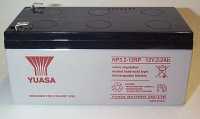
|
new from Maplin, RS and Farnell, they will provide a 500 amp maximum output, and thus may be useful for Robots. However, for their cost and weight they are not as good on paper as the Hawker batteries - this is because they are a lead calcium battery. Noteable robots that have used Yuasa batteries include Onslaught, Stinger and Hypnodisc.

|
 Dryfit are another battery that is available from RS and Farnell. The A500 series is the one most suited to robot use, and in typical robot sizes will supply a (fairly low ) 200 amp maximum output current - again these are lead calcium batteries. As with the Yuasa batteries, for their cost and weight they offer no advantage over the Hawker batteries. A notable A500 Dryfit user was Chaos 2 (in series 3 and 4), but the batteries that
Dryfit are another battery that is available from RS and Farnell. The A500 series is the one most suited to robot use, and in typical robot sizes will supply a (fairly low ) 200 amp maximum output current - again these are lead calcium batteries. As with the Yuasa batteries, for their cost and weight they offer no advantage over the Hawker batteries. A notable A500 Dryfit user was Chaos 2 (in series 3 and 4), but the batteries that
|
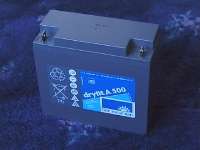
|
George was using were secondhand (ex-medical equipment, from a scrapyard).

|
 Steatite and MicroKiel (Kiel) - I lump these together because I am almost certain that these are the same battery - if they did not come from the same factory, then they are certainly the same design! I have seen at least five different names on exactly the same battery case (in dark grey, light grey and bright orange) used in robots from the UK and USA. On paper their specs are good, but the main advantage they offer is cost - even brand new, they're very cheap! Both ourselves and Chaos 2 used Kiels at Extreme, and Bigger Brother has also used Kiels. These are also lead calcium batteries.
Steatite and MicroKiel (Kiel) - I lump these together because I am almost certain that these are the same battery - if they did not come from the same factory, then they are certainly the same design! I have seen at least five different names on exactly the same battery case (in dark grey, light grey and bright orange) used in robots from the UK and USA. On paper their specs are good, but the main advantage they offer is cost - even brand new, they're very cheap! Both ourselves and Chaos 2 used Kiels at Extreme, and Bigger Brother has also used Kiels. These are also lead calcium batteries.
|
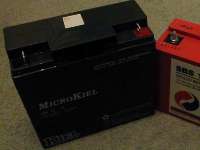
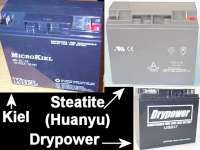
|
 Hawker batteries are in most peoples opinion the best - but they have an undeserved reputation for being expensive. Yes, the list price can be a lot, but if you shop carefully then they will cost no more than the Yuasas and Dryfits from RS etc. The Hawker range can be very confusing, and it is worth speaking to a dealer about what is available before making your choice, as Hawker seem to change their mind on what battery range is aimed at what market on a monthly basis. The majority of the (identical capacity) batteries are identical inside with just a different case and label, but beware that a lot of out of date literature exists both on the web and with some distributors. For example, the Odyssey PC680, Genesis G16EP and SBS J16 are almost certainly the same 16AH battery - compare the performance specs, dimensions and weights! The original SBS range are intended for aircraft and rally cars, while Genesis batteries are now aimed at backup applications, and Odyssey at high drain/cyclic applications (these are the only batteries currently warrantied for such use) - therefore if you are buying new batteries, you should be looking for Odysseys. The Odyssey range includes these batteries: PC535 (14Ah), PC545 (13Ah), PC680 (16Ah), PC625 (17Ah), PC925 (26Ah), PC1200 (42Ah), and PC1700 (70Ah).
Hawker batteries are in most peoples opinion the best - but they have an undeserved reputation for being expensive. Yes, the list price can be a lot, but if you shop carefully then they will cost no more than the Yuasas and Dryfits from RS etc. The Hawker range can be very confusing, and it is worth speaking to a dealer about what is available before making your choice, as Hawker seem to change their mind on what battery range is aimed at what market on a monthly basis. The majority of the (identical capacity) batteries are identical inside with just a different case and label, but beware that a lot of out of date literature exists both on the web and with some distributors. For example, the Odyssey PC680, Genesis G16EP and SBS J16 are almost certainly the same 16AH battery - compare the performance specs, dimensions and weights! The original SBS range are intended for aircraft and rally cars, while Genesis batteries are now aimed at backup applications, and Odyssey at high drain/cyclic applications (these are the only batteries currently warrantied for such use) - therefore if you are buying new batteries, you should be looking for Odysseys. The Odyssey range includes these batteries: PC535 (14Ah), PC545 (13Ah), PC680 (16Ah), PC625 (17Ah), PC925 (26Ah), PC1200 (42Ah), and PC1700 (70Ah).
 Hawker recommend that because all their batteries use a pure lead tin chemistry, for cyclic applications it is OK to charge their batteries at 14.4-15V with an unlimited maximum current, so long as great care is taken to only put in the same capacity that has been taken out
Hawker recommend that because all their batteries use a pure lead tin chemistry, for cyclic applications it is OK to charge their batteries at 14.4-15V with an unlimited maximum current, so long as great care is taken to only put in the same capacity that has been taken out
|
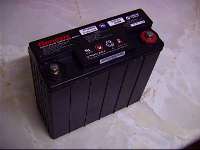
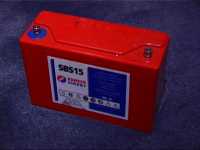
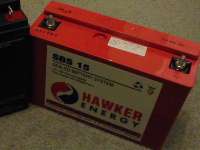
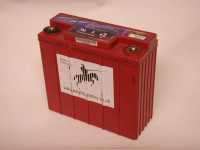
|
(which without a logging system in the robot, is very difficult!). Although some teams manage this sucessfully, we do not recommend this - the chemistry of the battery is still quite similar to other SLAs, and if you accidently overcharge your battery you will damage it. Again, it's cheaper to have a smaller charger and spare sets of batteries (although you do have the hassle of changing them between rounds!).

|
 Cyclon I've left as the last SLA for several reasons. Firstly, they're actually made by Hawker, and they've probably only been singled out for the second reason - because they're manufactured and available as single cells as opposed to only batteries of 12V. You can buy them as 6V monoblocks also. The largest useful capacity is only 8Ah which will deliver over 600 amps, but you've either got a lot of monoblocks or even more
Cyclon I've left as the last SLA for several reasons. Firstly, they're actually made by Hawker, and they've probably only been singled out for the second reason - because they're manufactured and available as single cells as opposed to only batteries of 12V. You can buy them as 6V monoblocks also. The largest useful capacity is only 8Ah which will deliver over 600 amps, but you've either got a lot of monoblocks or even more
|
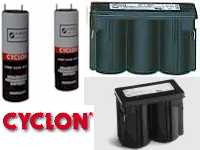
|
single cells to buy and connect. By the time you've connected them all up they will be at a weight and cost disadvantage, however a single damaged cell can easily be replaced, and if your robot design requires a very strange shaped battery pack, they could be the way to go. However they do not offer much capacity and do not make for an easy life. You can get them from RS, Farnell, and probably most Hawker distributors. A notable Cyclon user is Smidsy.

|
 Nicad - There are only two types of cell that are up to the job, and these both come from Sanyo - the 2.6Ah sub C size (N-2600CR) and 3Ah C size (N-3000CR) "Rapid Charge" cells, both as used in the american "Battlepacks". Nicads offer an advantage in terms of a weight saving over SLAs, but at a much greater financial cost (batteries and chargers), as well as more hassle (much greater care needed in the charging, monitoring and
Nicad - There are only two types of cell that are up to the job, and these both come from Sanyo - the 2.6Ah sub C size (N-2600CR) and 3Ah C size (N-3000CR) "Rapid Charge" cells, both as used in the american "Battlepacks". Nicads offer an advantage in terms of a weight saving over SLAs, but at a much greater financial cost (batteries and chargers), as well as more hassle (much greater care needed in the charging, monitoring and
|
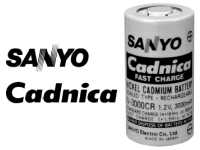
|
connection) and likelyhood of failure (one weak cell ruins the performance a battery pack - I have run RC cars for long enough to experience this!). One notable robot that has run Nicads sucessfully in the UK is Storm 2, while less sucess has been experienced by the Razer and Kan Opener teams. Standard "yellow" cells are not up to the job (as shown by Wild Thing, with the failure of their F cells) and normal sub C RC car packs are not designed for the high continuous currents demanded by heavyweight robots. However, RC car cells make a lot of sense in Featherweight robots, where the weight saving and ability to use basic off the shelf RC chargers pays off.

|
 Nimh - Currently there is only one type of cell that is up to the job. They are made by Saft, and are a prototype run of an F cell designed for automotive use, which is capable of a 270A maximum output current (the cell capacity is about 7Ah). The supply is limited and is really open only to sponsored teams. Notable users include Behemoth, Stinger and Draven. However, smaller Nimh packs make a lot of sense in Featherweight robots, and robots such as Force 4 and Force 10 from the Storm team use 3Ah sub C cell Nimh batteries.
Nimh - Currently there is only one type of cell that is up to the job. They are made by Saft, and are a prototype run of an F cell designed for automotive use, which is capable of a 270A maximum output current (the cell capacity is about 7Ah). The supply is limited and is really open only to sponsored teams. Notable users include Behemoth, Stinger and Draven. However, smaller Nimh packs make a lot of sense in Featherweight robots, and robots such as Force 4 and Force 10 from the Storm team use 3Ah sub C cell Nimh batteries.

|
For more information to help you choose your batteries, have a look at these pages on the Albatel site - Selecting the correct battery type, Lead Calcium and Pure Lead-Tin type batteries. Also look here for
battery information, in particular a big list of battery brands.
Making your own battery packs - SLAs
You can build up your own battery packs with using SLAs, but there's only one type of cell really suitable, and that's the Hawker Cyclon. In most cases standard Hawker Odysseys would be smaller, cheaper and lighter, so it's rare that you'd want to, other than possibly for different weight classes, such as Lightweight or Middleweight.
Making your own battery packs - Nicads or Nimh
At first sight it would seem logical to built up Nicad battery packs yourself. The cells are fairly cheap, and you just need to connect them up, right? Unfortunately it's not that simple - there are a few things you should consider.
 Building 6 cell sub C RC car packs is frustrating, so multiple packs with 20 or 30 cells will be very hard work indeed... You need some big thick heatshrink to cover the completed pack, proper bars to join the cells together, and a big soldering iron to solder the bars on. Unfortunately heating the cell to solder on the bar will shorten the life of the cell (overdo it and the damage to the cell will be serious), but there is no other reliable and low resistance means of connection. (Manufacturers often spot weld connecting bars to the cell, but this has a fairly high resistance and may not be mechanically reliable.) You also should use some kind of foam or plastic spacer to hold the cells apart - they only have a thin covering of heatshink over the can, which is at the -ve potential of the cell. This heatshrink is easily damaged (through vibration, or if the cell overheats!) and it is extremely easy to short out one cell in a pack in this way... I have seen it happen quite often in RC cars, when a fire (or worse exploded cell) results...
Building 6 cell sub C RC car packs is frustrating, so multiple packs with 20 or 30 cells will be very hard work indeed... You need some big thick heatshrink to cover the completed pack, proper bars to join the cells together, and a big soldering iron to solder the bars on. Unfortunately heating the cell to solder on the bar will shorten the life of the cell (overdo it and the damage to the cell will be serious), but there is no other reliable and low resistance means of connection. (Manufacturers often spot weld connecting bars to the cell, but this has a fairly high resistance and may not be mechanically reliable.) You also should use some kind of foam or plastic spacer to hold the cells apart - they only have a thin covering of heatshink over the can, which is at the -ve potential of the cell. This heatshrink is easily damaged (through vibration, or if the cell overheats!) and it is extremely easy to short out one cell in a pack in this way... I have seen it happen quite often in RC cars, when a fire (or worse exploded cell) results...
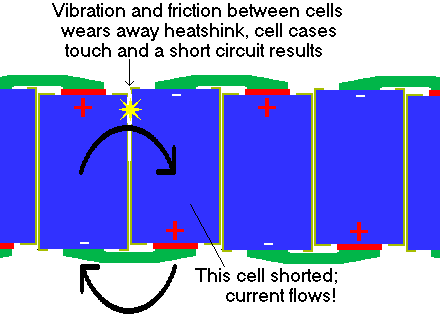
Without proper spacing we have a similar situation to the second dangerous one above, but worse - there will be a chain reaction effect as the heat generated by the shorted cell melts the heatshink on those OK cells nearby, causing them in turn to short, meanwhile the other (unshorted) packs are dumping current into the pack with the short... The remaining OK cells in the damaged pack are soon overcharged, and their terminal voltage then drops, encouraging even more current to flow into the damaged pack... You soon get a fire, as the Kan Opener team demonstrated at Louth!
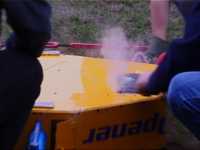
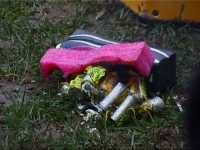 The situation is worse still if a cell in one battery pack were to fail whilst charging - suddenly it would have the other packs and the charger wanting to dump current into it! Hopefully it is obvious why proper spacing is essential.
The situation is worse still if a cell in one battery pack were to fail whilst charging - suddenly it would have the other packs and the charger wanting to dump current into it! Hopefully it is obvious why proper spacing is essential.
 You also must consider matching. Repeated charging and discharging of an unmatched battery pack will greatly stress the weakest (lowest capacity) cells, as they are overcharged during charging, and reversed when dead but the rest of the cells in the battery are still delivering current. If you buy a random batch of cells with which to built your packs, their capacity may be all over the place, and a poor quality battery pack will result. Any commercial nicad company worth their while will match the cells in the pack to ensure a similar capacity, good performance and long service life. (This happens in RC car racing - the top teams get the best cells, the majority are matched and sold as branded packs, while the dross gets flogged to hobby users!)
You also must consider matching. Repeated charging and discharging of an unmatched battery pack will greatly stress the weakest (lowest capacity) cells, as they are overcharged during charging, and reversed when dead but the rest of the cells in the battery are still delivering current. If you buy a random batch of cells with which to built your packs, their capacity may be all over the place, and a poor quality battery pack will result. Any commercial nicad company worth their while will match the cells in the pack to ensure a similar capacity, good performance and long service life. (This happens in RC car racing - the top teams get the best cells, the majority are matched and sold as branded packs, while the dross gets flogged to hobby users!)
If all the above is basic, simple and obvious, that's good. If you've learnt something that will stop you making an expensive mistake, then it's even better!
And so onto the Battery Recommendations...
| Series 4 (2000) (+ Display) || Series 5 (2001) || Series 6 (2002) |
| Home ||
Build Diary ||
Official Merchandise ||
Site Map ||
E-Mail |
|


 To complicate matters further, each type of cell technology can have several variations, which do not represent a completely different cell chemistry, but do affect how the cell performs in use. For example, sub C nicad cells as used in radio controlled cars are available in standard 1.2Ah SC, rapid charge 1.4Ah SCR, higher capacity 1.7Ah SCE, special radio controlled 1.7Ah SCRC, and more recent developments of the SCRC cell to provide capacities of 2 or 2.4Ah. Lead acid cells are available as basic Lead Calcium or the more advanced Pure Lead Tin types. The more advanced cells have higher capacity, lower internal resistance and greater efficiency, but normally they cost more!
To complicate matters further, each type of cell technology can have several variations, which do not represent a completely different cell chemistry, but do affect how the cell performs in use. For example, sub C nicad cells as used in radio controlled cars are available in standard 1.2Ah SC, rapid charge 1.4Ah SCR, higher capacity 1.7Ah SCE, special radio controlled 1.7Ah SCRC, and more recent developments of the SCRC cell to provide capacities of 2 or 2.4Ah. Lead acid cells are available as basic Lead Calcium or the more advanced Pure Lead Tin types. The more advanced cells have higher capacity, lower internal resistance and greater efficiency, but normally they cost more!



 Robot Wars used to recommend three complete sets of batteries, although with a good charger and a bit of luck you can get away with two sets, especially if you don't realistically expect to progress past the end of your heat. One set is definately not recommended - you're unlikely to get them fully charged in time, and you won't have spares to replace any damaged ones. It's better to have lots of batteries and a slower charger - it'll cost you the same as a big charger and only a few batteries, your batteries will last longer, and you'll have spares.
Robot Wars used to recommend three complete sets of batteries, although with a good charger and a bit of luck you can get away with two sets, especially if you don't realistically expect to progress past the end of your heat. One set is definately not recommended - you're unlikely to get them fully charged in time, and you won't have spares to replace any damaged ones. It's better to have lots of batteries and a slower charger - it'll cost you the same as a big charger and only a few batteries, your batteries will last longer, and you'll have spares.


 You also must consider matching. Repeated charging and discharging of an unmatched battery pack will greatly stress the weakest (lowest capacity) cells, as they are overcharged during charging, and reversed when dead but the rest of the cells in the battery are still delivering current. If you buy a random batch of cells with which to built your packs, their capacity may be all over the place, and a poor quality battery pack will result. Any commercial nicad company worth their while will match the cells in the pack to ensure a similar capacity, good performance and long service life. (This happens in RC car racing - the top teams get the best cells, the majority are matched and sold as branded packs, while the dross gets flogged to hobby users!)
You also must consider matching. Repeated charging and discharging of an unmatched battery pack will greatly stress the weakest (lowest capacity) cells, as they are overcharged during charging, and reversed when dead but the rest of the cells in the battery are still delivering current. If you buy a random batch of cells with which to built your packs, their capacity may be all over the place, and a poor quality battery pack will result. Any commercial nicad company worth their while will match the cells in the pack to ensure a similar capacity, good performance and long service life. (This happens in RC car racing - the top teams get the best cells, the majority are matched and sold as branded packs, while the dross gets flogged to hobby users!)